Legacy Series Episode 2 - Fighter Command
In Episode 2, RCAF veterans describe the personal experience of flying fighter missions during the Second World War. From providing aerial cover to taking part in hair-raising dogfights, their firsthand accounts are shared with self-deprecating humour, bringing history to life in an engaging and often moving way. Topics include the learning curve, tank busting, the perils of friendly fire, and the stress that made some young flyers go off the rails.
The interviews are interspersed with archival photographs and film footage. Scenes between Cadet Andy and Captain Johnny C provide context and additional information on what it was like to go to war.
Transcript
0:13
What you remember is the things when you know you’re going to die—but you don’t (laughs).
0:24
You’re so sure you’re going to die, but then you don’t do it.
0:32
And I had two occurrences like that.
1:43
When Dieppe occurred, a group of us—a part of the squadron—we were the top cover.
1:50
And because I was on, really, my first real operation, I stuck to the tail of my leader,
2:00
and I didn’t see very much, really.
2:04
Just the tail of the aircraft.
2:06
And we were top cover, where there really wasn’t much action.
2:10
But down below, you could see the smoke and the activity, and it was real hell.
2:18
But that was my first introduction to operations.
2:26
Man, the Spitfire is still an amazing looking aircraft.
2:33
Don’t let her good looks fool ya.
2:34
She’s fast and deadly.
2:36
Just ask the Germans.
2:37
They saw enough of them during the Battle of Britain.
2:42
Weren’t they just throwing untested pilots into that battle? The Brits were so outnumbered.
2:48
Sometimes. But for the most part procedure still has to be followed.
2:53
Fighter pilots always have to watch and learn before they can get their feet wet.
2:59
It must have been hard for those rookie fighter pilots to just hang back and watch.
3:04
They must be itching to get into the fight.
3:06
If they did get into it, they’d be like a lamb to slaughter.
3:10
It takes time to become a fighter pilot.
3:13
Things are coming at you at breakneck speeds.
3:16
You have to learn to make decisions before you can even think about them.
3:21
You have to know how to avoid flaming out before you can notch up your own victories.
3:28
It’s not like us bombers, who get put in the mix pretty much right away.
3:34
If you’re in a Spit, or a Lanc, or a cargo glider for that matter,
3:40
on your first time out, you’re scared like you never known what scared is.
3:46
You get over it somewhat, but it’s always on your mind.
3:50
Weighing you down.
3:53
But the more I fly, the more I can control it.
3:56
Yeah it’s like exams for me.
3:57
The more I do them, the better I do.
3:59
But it’s a little bit different up there.
4:06
When you are in that insanity around you.
4:11
All the training in the world can’t give you what you really need to come back in one piece.
4:18
And what’s that?
4:21
Lady luck.
4:40
The one flight that probably stands out in my mind is the second 109 that I shot down.
4:48
You know for three and a half years overseas, I shot down two 109s.
4:52
On this one, we were flying as a squadron of twelve.
4:58
And I spotted a Jerry formation.
5:01
You could tell it was the Jerries from the way they flew.
5:04
When they went through cloud, unlike us, they went into line-abreast
5:08
which made a lot of sense to me, because they all came out together.
5:12
And I spotted this off in the distance, and I drew it to the attention of the squadron leader.
5:16
He couldn’t see them.
5:18
So he asked me to take over—I was leading a four-man section
5:21
—take over and go in that direction, which I did.
5:26
And after a while, he picked them up, too.
5:29
And somehow he was able to manoeuvre us so that we were flying line-abreast right behind
5:35
the Jerries and a hundred feet below them, and they hadn’t spotted us.
5:39
And, at that point, he said “Every man for himself,” or something like that.
5:45
He opened fire on his and I opened fire on mine.
5:51
The one I had was carrying a 500-pound bomb under the belly.
5:54
Well, he got rid of that in a hurry!
5:57
And he broke tighter than the first one I got—so tight that,
6:00
while I could turn inside him, I couldn’t turn that last bit to lead him.
6:07
If I’d tried shooting, I’d just be wasting my shots.
6:13
And he kept this up for about three turns, and then he pulled a stunt that I was aware of,
6:17
but hadn’t encountered before—where he suddenly levelled off and closed the throttle.
6:25
So immediately, I have three choices to make: collide with him, turn to the left,
6:31
or to the right—in which case, I would overshoot him,
6:34
and he’d be able to turn in behind me, and I’m a dead goose.
6:36
So, for some reason or other, I rammed on full rudder,
6:41
put the ailerons in the opposite direction, and skidded flat-out beside him.
6:48
Almost hit his tail—just missed his tail.
6:50
I slid out beside him.
6:53
I was within a foot of his wingtip with my wingtip,
6:56
and I was gradually sliding past him.
6:59
So I fishtailed on the rudder to stop that.
7:03
And we ended up flying wingtip to wingtip.
7:06
And I could still remember looking across at the Jerry sitting there;
7:10
and he had on a light-coloured flying jacket of some kind.
7:12
Now, he’s looking at me, and I’m looking at him, saying who’s going to quit first?
7:19
Well, I knew that his stalling speed was higher than mine, so he was going to have to do something first.
7:25
And what he did was open the throttle quick.
7:28
He left me about 300 yards behind.
7:30
Well, I wasn’t going to give him another chance to get into this turning business.
7:34
So, at about 300 yards, with my sight right on his cockpit, I gave him a sharp burst,
7:40
and immediately his canopy flew off.
7:43
But he kept flying, so I gave him another sharp burst, and out comes the parachute.
7:50
I looked around, and there was nobody in the sky.
7:53
We were alone, the two of us.
7:55
So then I thought, geez, nobody to witness it.
7:58
I wouldn’t be able to claim this, and I was determined I was gonna claim it.
8:02
So I thought: I’ll take his picture.
8:05
So I came around in a big turn, got him nicely lined up with the camera,
8:11
and I was just about to take his picture when I realized I was going to hit him.
8:14
I still had my throttle wide open from chasing him.
8:18
So I throttled right back, and came around in a bigger loop, and caught him
8:26
and I have a perfect picture of him and his parachute going down.
8:28
And after that I came home.
8:31
And I found out from the German records later that he had been wounded with the first shot
8:38
or the second, but that’s why he jumped out.
8:43
But believe it; the story is true (laughs).
8:49
Why was it called a dogfight?
8:51
Why not Clash of Eagles?
8:53
Or, Death Duel in the Skies.
8:55
What do dogs have anything to do with flying?
8:58
Quit flapping your gums for a moment and I’ll tell ya.
9:01
A dogfight is a fierce battle between two mad dogs fighting to the death.
9:07
It really describes it, don’t you think?
9:10
Two planes ducking and diving.
9:12
Spinning and shooting.
9:14
Hell bent on destroying each other.
9:16
What’s even crazier is most of these dogfights last on average of no more than 30-seconds!
9:22
And each Spitfire is only loaded with 15-seconds of continuous gunfire.
9:27
So do the math there, Andy.
9:31
Those fighter pilots they get the life.
9:35
The glamour.
9:37
A couple of quick engagements and they’re back for afternoon tea and crumpets.
9:43
It's not like us in bomber command.
9:46
We’re like the turtle and they’re the hare.
9:49
But the turtle always wins.
9:52
Slow and steady wins the race.
9:54
In this race…slow and steady gets you lined up in enemy gun sights and shot down.
10:01
There's no glory in that.
10:03
So were you fighting for personal glory or to kill the enemy?
10:06
Maybe a little of both.
10:09
But is their really any glory in killing another human being?
10:14
I suppose there is…if they’re trying to kill you.
10:35
The Spitfire was light and manoeuvrable, fun to fly.
10:45
The Typhoon wasn’t—but it was exciting to fly, because you were doing exciting things.
10:55
What we could do with a Typhoon was attack columns of tanks.
11:03
And every tank had to have men with them to operate that tank.
11:10
The crews, the soldiers that went along and fought with that tank, the German soldiers, the mechanics
11:22
to work on that tank, fuel, ammunition for the tank, all that kind of stuff.
11:30
With a Typhoon you could kill all them trucks and make a mess of them,
11:37
and block the roads for one thing.
11:39
So to go down there for a Typhoon was like a shooting gallery.
11:44
So it was referred to as a tank buster.
11:48
An excellent low-level attack aircraft—an excellent one!
12:11
In doing our work, we were attacked quite frequently
12:17
—more than occasionally by American aircraft, who had difficulty in recognizing the Typhoon as an Allied aircraft.
12:30
It’s the truth, and it should be told.
12:37
Our CO was new to that area.
12:41
He’d been fighting in Europe, had a good name.
12:46
But he had no experience with the topography there.
12:52
He told ’em, “After three roads, you can attack anything you see.
12:58
It’ll be the enemy.”
12:59
So we counted three roads.
13:01
But one of them wasn’t a road; it was just a trail.
13:05
The next road we saw trucks on.
13:08
We started shooting, and they were a British army.
13:13
Fortunately, we didn’t kill anybody!
13:20
To be killed by one of your own planes.
13:22
That must have been the worst thing to happen to you over there.
13:26
How’s that even possible?!
13:27
It happens all the time in war.
13:29
And believe me, there are worst things in war.
13:32
Like what?
13:34
You think hard enough Andy and I’m sure you can come up with a few.
13:55
Normally, in Spitfires—these were beautiful, the Spitfires. They didn’t have gunsights or guns or anything.
14:02
They had more fuel tanks in them, and they could go farther—very smooth things.
14:10
They would go out on an exercise.
14:12
If there’s an attack somewhere that the Army wanted a picture of
14:20
—if there are any tanks in the area or something like that —they would take pictures.
14:24
They had a camera that did a vertical and then two obliques.
14:30
So, they could fly down along close to a thing and take an olique picture of it, or fly over and take a vertical.
14:43
I bet you never knew that in the First World War the primary role of the aeroplane
14:49
was to gather information and find out what the enemy was doing behind their trenches.
14:54
It wasn’t to shoot down the Red Baron like some of them picture shows lead you to believe.
15:00
No sir, solid reconnaissance saved lives in that war.
15:06
Same is true in this war.
15:08
And they used a Spit?
15:10
That’s right.
15:11
We use a “Spit”.
15:12
Multi-engined aircraft are just too slow.
15:15
Too easily picked off by Jerry fighters.
15:17
But not the “Spit”.
15:20
Did you know that most are unarmed?
15:24
They fly deep behind enemy lines, armed with only cameras to find out what the Fuhrer is up to.
15:30
You know what they say, knowledge is power.
15:33
Really?
15:34
I thought who ever had the biggest gun holds the power.
15:55
I’d been on patrol over London on an eye for item: Beacon.
16:00
Well I took off way up into the Cambridge area.
16:04
We caught up to a German airplane going out into the North Sea.
16:07
He was going home flat-out.
16:11
It was a different model; it was either a Junkers 388 or a 188.
16:16
And my navigator—who was a real enthusiast on information like that—after we shot it,
16:22
it was in flames and going down.
16:25
He said, “Let’s get in closer, so I can give more information to the intelligence people when we get on the ground.”
16:31
It was the stupidest thing I ever did in my life.
16:33
I moved on in and, as I was getting close—and the airplane was completely in flames,
16:39
but the mid-upper gunner was still in his turret on this airplane,
16:43
and I saw the turret moving around to bear it on me.
16:49
I broke as hard as I could to the left, and he started about six inches from one wingtip
16:55
and finished up about six inches from the other wingtip.
16:57
He put thirty-some rounds of 13 mm into my airplane.
17:02
Two or three through the cockpit.
17:04
My navigator has Perspex into his face and things.
17:10
We sat side by side; and one of the bullets went right through between the two of us, amongst other things.
17:17
Well, both engines were badly shot-up.
17:22
One of them: the piston was shot right out of it on the right-hand engine.
17:27
I was going to crash-land,—called (the radio was still working)
17:32
—at the big bomber crash strip, up in Norfolk.
17:36
They said, “We can’t take you, because the air is littered with bombers coming back from a raid.”
17:43
So we tried and we went on to Bradwell Bay, which was about another fifty-sixty miles,
17:49
with this airplane in this shape.
17:52
We landed.
17:53
One thing that is most interesting on that, when I went to put on the brakes, there weren’t any brakes.
18:00
One of the rounds had gone through the air bottles in the back, so I ground-looped in the middle of the airfield
18:06
and there was the airplane, just dripping fuel and all the rest; it never caught fire.
18:10
And that, without a question of a doubt, was the most interesting one in the war.
18:33
You’ve heard of people who were cowards
18:39
in the First World War, they used to stand them up against a wall and shoot them.
18:44
But in our war, they were called LMFs: Lack of Moral Fibre.
18:52
So, one South African lad was posted to the squadron.
18:56
By this time, I was a Flight Leader.
19:00
And he was assigned to me to train initially.
19:06
The first time we took off, I was leading a flight onto— I think it was an Army support operation.
19:16
And we’d no sooner gotten airborne and he said: “My engine’s giving me trouble;
19:21
I have to return home.”
19:24
This wasn’t unusual.
19:25
A lot of people, on their first flight, imagined they had engine troubles.
19:31
So we let him go home.
19:33
I still had another five of us to do the job.
19:38
The next time I took him up, there was just the two of us, and we were going on an interdiction.
19:46
And I could see miles ahead.
19:49
There was dust rising off this road; I knew there was something coming.
19:54
So I said to this kid, “Arm your guns and put on your gunsight.
19:58
Be prepared.
19:59
I’m gonna fire on this target.”
20:03
As soon as we got within range, I did go in and I fired my guns and look. . . nothing happened.
20:12
I looked around, and here was dust coming up in the jungle about a quarter of a mile away.
20:18
It was a new airplane—just been overhauled, just come to the squadron,
20:22
and they put me in it and they never checked to see that the guns were harmonized.
20:27
So instead of the guns pointing ahead, the guns were pointing like this (laughs).
20:33
So I passed over this target, and it was a touring car:
20:38
a touring car like Hitler used to ride, with two Japanese generals and a driver.
20:44
I could see their red epaulettes and collar tabs.
20:50
And their car was half tilted-over into ditch, and they were running across to the jungle.
20:58
I looked to see the bullets from my Number Two.
21:03
Nothing happened.
21:05
So I pulled up and I said, “Why didn’t you fire on that target?”
21:08
He said, “I don’t see anything, Sir.
21:11
I don’t see anything, Sir.”
21:13
What do you mean you don't see anything?
21:14
There’s this pile of dust for miles, leading straight to it.
21:19
I said, “Okay, I’ll fly low over this; it’s a vehicle.
21:24
When I’m directly over it—I’ll tell you when—and then you go ahead and destroy it.
21:29
You’re not going to kill anybody ‘cause there’s nobody in it.
21:33
Just destroy it, and you’ll maybe reduce the length of the war by a few hours.”
21:42
I watched him; he didn’t do anything.
21:44
He just flew around.
21:46
I said, “Aren’t you going to destroy that vehicle?”
21:48
“I don’t see anything, Sir.
21:50
I don’t see anything, Sir.”
21:51
That’s what he kept saying.
21:55
So, I guessed that he was an LMF by then.
21:58
Then we went home.
22:02
But I thought I’d give him one more chance.
22:06
We went off with just the two of us, again.
22:11
But we no sooner got airborne when this kid said, “My engine’s giving me trouble.”
22:17
I said, “Go on home.
22:19
I’ll talk to you when we get home.”
22:22
I wasn’t supposed to continue, because we weren’t allowed to fly singly
22:26
—supposed to be no less than two—but I went anyway!
22:31
And, about five minutes later, I saw a mass of airplanes coming toward me—the sky was full of airplanes.
22:41
As I passed under them, about 400 feet below them, of course they all had Rising Suns.
22:48
I roughly counted about fifty Japanese fighters.
22:54
I was, of course, frozen stiff (laughs).
23:00
But I watched them to see if any broke off from the formation.
23:05
But they didn’t; they just flew on—they flew right by me.
23:10
So I called operations and gave the number of aircraft, the exact position of them,
23:17
and the exact direction they were flying.
23:19
But the kid obviously heard my message to operations, and he panicked.
23:29
And he either landed with his brakes on, or he landed and tried to stop too fast.
23:37
The engine stalled, and the Merlin engines made a lot of crackling noise when they were cooling down,
23:43
and he believed that his aircraft was on fire.
23:50
Anyway, a bunch of troops that were in a slit trench on the side of the runway,
23:54
waiting for the Japanese, ran out, lifted up the aircraft, and hauled him out.
23:59
And he was a raving maniac.
24:02
They had to hold him down; It took four of them to hold him down ‘til the raid was
24:06
over and an ambulance came and took him away in a straightjacket.
24:10
And I never saw him again.
24:16
Lack of Moral Fibre is just a fancy way of saying that someone had no guts. Right?
24:22
That they were a coward.
24:23
It’s not that simple Andy.
24:27
Let me see if I can explain it to you.
24:31
Sortie after sortie, every pilot of fighter planes, or every crewmember of a Lanc,
24:39
or any aircraft for that matter, they risk everything up there.
24:45
Day and night we bring the war to the enemy and guys break down.
24:54
It’s not that they care more about their own survival.
24:56
It's that it all becomes too much for them.
25:00
And sometimes they just can’t pull themselves up by the bootstraps.
25:05
The things we do to each other in war, it’s just not natural.
25:14
One day you’re dancing at home to Glenn Miller with your best gal and next you’re here.
25:23
You witness how horrible death can be.
25:27
But what choice do we have?
25:28
It’s either them or it's us…No guts?
25:35
Tell me what “guts” are Andy?
25:39
I think it takes real guts not to fight.
25:42
And let others fight your battles?
25:46
Sacrifice their lives.
25:50
Is that fair?
26:10
I met a fellow by the name of Percy Kearse from out West.
26:14
And Percy and I became friends there.
26:16
We sort of stuck together, by luck, at the next posting.
26:20
Percy and I went through training together.
26:23
The flight commander was going to take us on an op.
26:27
So then I said to him, are we ready to take off?
26:31
And there wasn’t anybody who could get their aircraft going.
26:34
So I said, “If everything gets going, I’ll fly fighter cover for you.”
26:39
Which is unusual to do such a thing, but I did.
26:43
And I watched Percy start off in his dive, and he just blew up.
26:47
Must have got hit, in one of the bombs with a piece of shrapnel or something.
26:52
It just blew up, you know?
26:59
So...Sorry.
27:21
It was my stupid day, really.
27:23
It was my day off.
27:25
And I’d gone down to the flight line, and I was waxing my aircraft so I could get another little bit of speed out of it.
27:35
The other flight said, “Lloyd, we’re short of pilots.
27:39
Can you fly with us today?”
27:43
I said, “Sure.”
27:45
And off we went, and my radio went out.
27:50
I didn’t have any radio, and I stupidly stayed with them, and we were attacked by 109s,
27:59
and I didn’t see it.
28:00
My Number Two broke and I was on my own, and I saw two 109s down there.
28:07
I went down and I thought, “Boy I’m gonna be a hero today.”
28:11
And, next thing I knew— I weaved, you know.
28:14
And I looked back, and this guy was shooting at me.
28:18
The aircraft was badly hit: a shell hit the fuselage right about here,
28:25
and bits and pieces went through into my arm.
28:29
But the airplane was still flying, so I spun down to a fairly low altitude,
28:36
and then headed towards home.
28:40
The engine quit on me.
28:41
I found a flat spot, and I sat it down there.
28:46
I left everything there.
28:48
Nearby was a series of trees going up the mountain, and there was a stream that had dried up.
28:59
But there were trees on either side, and I felt secure in there, out of sight.
29:05
I tore my shirt up, and bandaged my arm, and then walked up the stream bed.
29:13
And I was well into the field when an armoured car came down the road.
29:20
They took me to a casualty clearing centre.
29:23
I remember the doctor saying now, “You start counting backwards from ten.”
29:28
I don’t think I got very far before I went to sleep.
29:33
When I woke up, my arm was in a bandage.
29:37
However, I couldn’t get any of the doctors to phone my unit to tell them that I was OK.
29:43
I think it was ten days that my mother hadn’t heard anything about it.
29:50
She got the signal that I was missing.
29:54
And it must have been awful, because she was all alone.
29:57
Dad was in the service, and he was away.
30:02
I think that was probably the thing that killed her, because in 1951, she died.
30:12
It was from a nervous colitis problem that probably was generated at that time.
30:20
I feel somewhat guilty about that.
30:30
Not being able to talk to your loved ones back home, that must have sucked.
30:36
Sucked?
30:37
Tough.
30:38
It must have been tough.
30:40
Damn tootin’ it’s tough.
30:43
There’s a whole heap of worrying going on back home.
30:47
And, we don’t always get their letters.
30:50
And they don’t always get ours.
30:53
Any news from the front, good or bad, never gets to the ones we left behind fast enough.
31:02
I guess the time spent not knowing, must have been the worst thing of all?



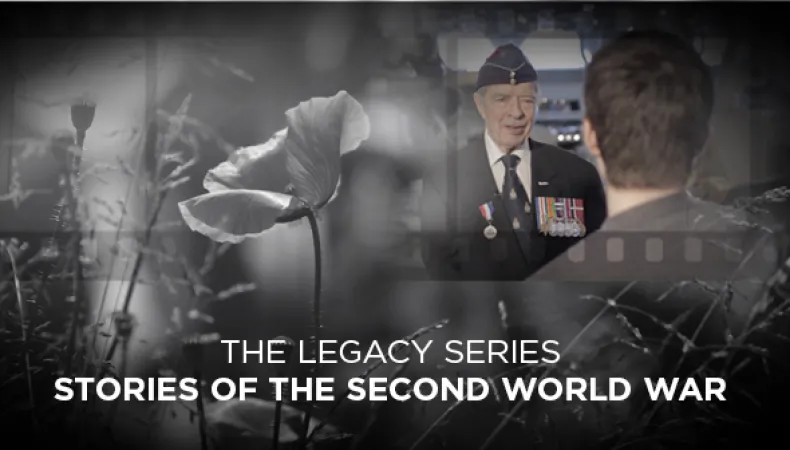

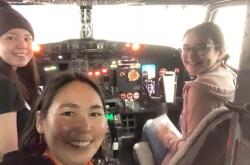
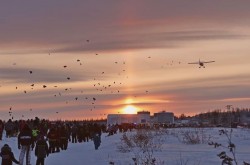
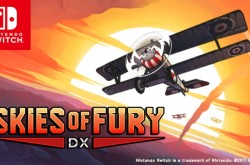
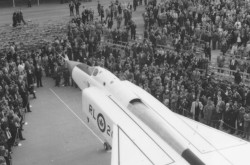
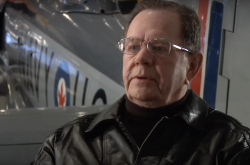




![A block of photographs showing some of the people involved in the bombing of beluga whales in the estuary and gulf of the St. Lawrence River. Anon., “La chasse aux marsouins [sic]. » Le Devoir, 15 August 1929, 6.](/sites/default/files/styles/thumbnail_7/public/2024-09/Le%20Devoir%2015%20aout%201929%20page%206.jpg?h=584f1d27&itok=TppdLItg)






